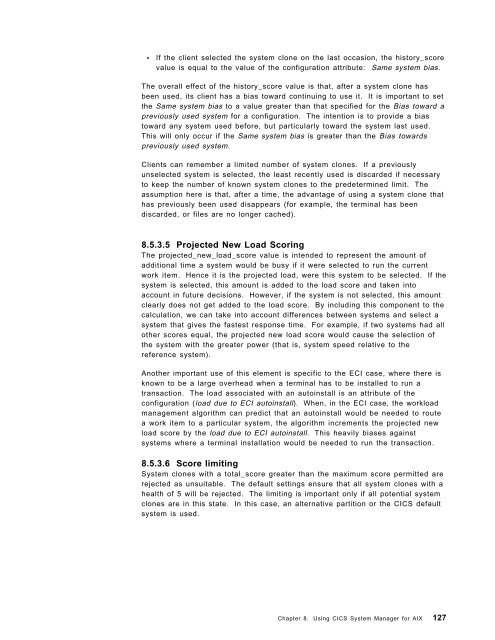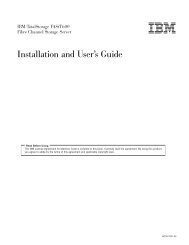Addressing OLTP Solutions with CICS: The Transaction Server ... - Ibm
Addressing OLTP Solutions with CICS: The Transaction Server ... - Ibm
Addressing OLTP Solutions with CICS: The Transaction Server ... - Ibm
You also want an ePaper? Increase the reach of your titles
YUMPU automatically turns print PDFs into web optimized ePapers that Google loves.
• If the client selected the system clone on the last occasion, the history_score<br />
value is equal to the value of the configuration attribute: Same system bias.<br />
<strong>The</strong> overall effect of the history_score value is that, after a system clone has<br />
been used, its client has a bias toward continuing to use it. It is important to set<br />
the Same system bias to a value greater than that specified for the Bias toward a<br />
previously used system for a configuration. <strong>The</strong> intention is to provide a bias<br />
toward any system used before, but particularly toward the system last used.<br />
This will only occur if the Same system bias is greater than the Bias towards<br />
previously used system.<br />
Clients can remember a limited number of system clones. If a previously<br />
unselected system is selected, the least recently used is discarded if necessary<br />
to keep the number of known system clones to the predetermined limit. <strong>The</strong><br />
assumption here is that, after a time, the advantage of using a system clone that<br />
has previously been used disappears (for example, the terminal has been<br />
discarded, or files are no longer cached).<br />
8.5.3.5 Projected New Load Scoring<br />
<strong>The</strong> projected_new_load_score value is intended to represent the amount of<br />
additional time a system would be busy if it were selected to run the current<br />
work item. Hence it is the projected load, were this system to be selected. If the<br />
system is selected, this amount is added to the load score and taken into<br />
account in future decisions. However, if the system is not selected, this amount<br />
clearly does not get added to the load score. By including this component to the<br />
calculation, we can take into account differences between systems and select a<br />
system that gives the fastest response time. For example, if two systems had all<br />
other scores equal, the projected new load score would cause the selection of<br />
the system <strong>with</strong> the greater power (that is, system speed relative to the<br />
reference system).<br />
Another important use of this element is specific to the ECI case, where there is<br />
known to be a large overhead when a terminal has to be installed to run a<br />
transaction. <strong>The</strong> load associated <strong>with</strong> an autoinstall is an attribute of the<br />
configuration (load due to ECI autoinstall). When, in the ECI case, the workload<br />
management algorithm can predict that an autoinstall would be needed to route<br />
a work item to a particular system, the algorithm increments the projected new<br />
load score by the load due to ECI autoinstall. This heavily biases against<br />
systems where a terminal installation would be needed to run the transaction.<br />
8.5.3.6 Score limiting<br />
System clones <strong>with</strong> a total_score greater than the maximum score permitted are<br />
rejected as unsuitable. <strong>The</strong> default settings ensure that all system clones <strong>with</strong> a<br />
health of 5 will be rejected. <strong>The</strong> limiting is important only if all potential system<br />
clones are in this state. In this case, an alternative partition or the <strong>CICS</strong> default<br />
system is used.<br />
Chapter 8. Using <strong>CICS</strong> System Manager for AIX 127
















